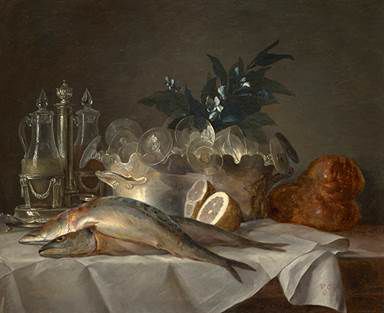The Kimbell Art Museum announced March 7 that it has acquired Anne Vallayer-Coster’s 1787 painting Still Life with Mackerel.
“Anne Vallayer-Coster is one of the very few female artists who managed to negotiate the powerful authority of the Royal Academy in Paris and to exhibit their work at the Salon,” Eric M. Lee, director of the Kimbell Art Museum, said in a news release.
Still Life with Mackerel went on view March 8 in celebration of International Women’s Day in the Kimbell’s Louis I. Kahn Building. Vallayer-Coster (1744–1818) is considered one of the foremost still-life painters of 18th century France.
The painting is a gift from Sid R. Bass in honor of Kay and Ben Fortson, long-time leaders of the Kimbell Art Foundation’s board of directors.
“Her recognition as a leading painter of still life paralleled her contemporary Elizabeth Vigée Le Brun’s fame as a portraitist – both were favorites of Queen Marie-Antoinette. We are thrilled that Vallayer-Coster’s Still Life with Mackerel will join Vigée Le Brun’s Self Portrait as a highlight in the Kimbell’s collection,” Lee said.
Vallayer-Coster was born in Paris in 1744, the daughter of a goldsmith employed by the royal Gobelins Manufactory who later opened a shop near the Louvre and Tuileries Palace.
The Kimbell said in the news release that little is known about her training, and it is likely that she was largely self-taught. By the age of 26, she was received and accepted as a member of the Académie Royale de Peinture et de Sculpture (French Royal Academy of Painting and Sculpture). Very few women had previously achieved this distinction.
Although many women in 18th century France were practicing artists, their exclusion from the official, sanctioned and prestigious Academy limited their opportunities for training, public exposure and patronage.
It was perhaps the 18th century version of the glass ceiling for female artists.
It also prevented them from engaging in the genres considered to be most valued – above all history painting, which was rooted in the study of the human figure. For reasons of propriety, women were excluded from life-drawing classes that included nude models and were shunted to the so-called lesser genres, especially portraiture and still life.
Nancy E. Edwards, curator of European art at the Kimbell, noted that issue in an interview about the current Kimbell exhibition, The Lure of Dresden: Bellotto at the Court of Saxony, on view to April 28.
“Women often were portraitists because that’s something that they could do more readily. You didn’t have to study the nude figure to do a portrait,” she said.
“In Dresden it’s very interesting that there were several very gifted female artists. They were Italian and actually were invited to the court of Dresden, including Rosalba Carriera, who was a portraitist in pastel,” Edwards said.
It was later in the 18th century that artists such as Le Brun, through some of her connections, were able to join the Academy, Edwards said.
The museum said Vallayer-Coster’s painting is one of the most refined pictures produced by the artist.
Still lifes of fish were rare in 18th century France, where images of meat, fruits or flowers were more abundant.
Vallayer-Coster’s charming, original composition celebrates the arrival of mackerel in Paris in springtime, when wealthy Parisians enjoyed the freshest specimens, the museum said in its news release.
Arranged on a stone parapet covered by a linen cloth are a silver oil-and-vinegar cruet stand, a silver verrière (wine glass cooler) filled with crystal stemware, a lemon, a sprig of orange blossoms and a brioche (a rich pastry).
“The damask cloth cleverly mimics the type of linen the artist would have maintained in her own household: the initials V and C are embroidered in tiny red cross-stitch, along with the figure 6, an inventory number for the accounts of the painter’s housekeeper,” the Kimbell announcement said.
The museum is open 10 a.m.—5 p.m. Tuesdays-Thursdays and Saturdays; noon—8 p.m. Fridays; and noon—5 p.m. Sundays. It is closed Mondays.
Admission to the permanent collection is free. Special exhibitions require a ticket.
For more information: www.kimbellart.org/visit
– FWBP Staff






